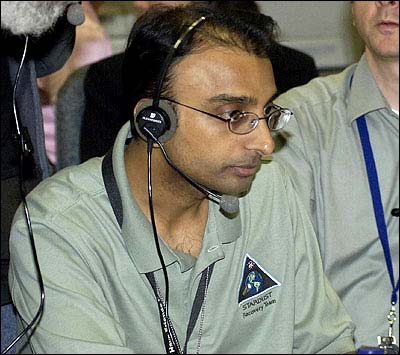 As the Phoenix Mars Lander pokes around for life on Mars in what is clearly mankind's most ambitious space project yet, there's an Indian bang in the middle of it all.
As the Phoenix Mars Lander pokes around for life on Mars in what is clearly mankind's most ambitious space project yet, there's an Indian bang in the middle of it all.
Prasun Desai is the project's senior engineer and Entry, Descent and Landing lead engineer, Langley Research Centre, Virginia, one of the four agencies working on the Phoenix project. The other three are NASA's Jet Propulsion Laboratory in Pasadena, University of Arizona and Lockheed Martin Space Systems.
While the University of Arizona leads the mission, JPL manages the project and Lockheed Martin built the aircraft. Desai's unit is playing a supportive, albeit equally important, role in the project, says NASA's web site.
"Our role is to help with redevelopment of the EDL system," Desai is quoted on NASA's web site. "We are supporting JPL and Lockheed Martin by defining the requirements for Phoenix's design so that it can meet what it needs to do when it lands on Mars."
Desai says NASA wants Phoenix to gather clues and answer critical questions like: Can the Martian arctic support life? What is the history of water on the planet? How do the polar dynamics affect Mars's climate?
"We use simulations and software tools to wring out the system as best as it is possible to try and improve it," Desai says. Adds Eric Queen, research engineer at Langley: "We understand the system better and we believe the system will do what it's supposed to do because we've simulated it so many different ways."
Also See: At Last! A Touchdown on Mars
One of the major challenges facing the project was the mode of Phoenix's landing. Unlike the previous missions to the red planet like Spirit and Opportunity, which used airbags for landing, Phoenix used propulsive engines to slow its descent before landing on three legs.
"It's a more sophisticated lander than the landing systems we've had so far," points out Desai.
The mission will determine if there is water ice on Mars's subsurface, how much of it is there and whether it can be used in the future.
"Ice there helps future missions significantly because you can live off the land," says Desai. "You can melt the ice and have water so that, whenever we send humans there, they have something to drink and not bring water with you."
Apart from that, humans can also obtain oxygen from the water ice. "Knowing how much water is on Mars helps us get an idea of what resources are there so we can try to anticipate how we do future missions from that perspective."
Photograph courtesy: NASA





